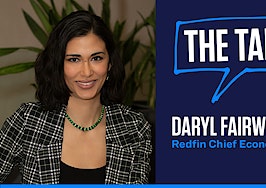This report is available exclusively to subscribers of Inman Intel, a data and research arm of Inman offering deep insights and market intelligence on the business of residential real estate and proptech. Subscribe today.
Developing a “super app” for consumers. Acquiring — and beefing up — the ubiquitous ShowingTime suite for agents. Striving for a greater chunk of the lead-generation market.
These have been some of Zillow’s most prominent public goals since the Seattle-based real estate search giant closed the book on its capital-intensive iBuying program last year.
But central to these efforts is a less flashy — but no less ambitious — plan to transform the listing portal from a relatively small player into a greater power in an area for which its throngs of website users traditionally haven’t turned to Zillow: Mortgage lending.
“Zillow Home Loans is central to our vision of building the housing super app — a single digital experience to help customers across all their real estate needs, including buying, selling and financing,” Racquel Russell, the company’s vice president of partner success, said in a statement to Intel.
Zillow’s efforts to supercharge the growth of its mortgage business will require no less than a rewiring of its user interface, a deeper integration with Premier Agent partners, and a substantial investment in its loan-officer operation, according to an Intel review of shareholder documents and interviews with Zillow executives.
It’s also geared toward reaching a particular clientele: buyers who prefer to start their home search with financing approval.
“From a mortgage perspective, we’re building a digital experience with fully underwritten pre-approvals and tools,” Zillow President Susan Daimler said in a previous interview with Intel.
In full, it’s a plan so ambitious that when Intel raised the idea in a phone call with real estate analyst Mike DelPrete, he immediately started listing off the challenges that the company would have to overcome to get its mortgage business to where it wants to be.
“Zillow may or may not figure out the magic formula,” DelPrete said. “But if I had a dollar every time I heard a company say, ‘Yeah, we’re gonna get into mortgages,’ I’d be a millionaire.”
For their part, Zillow executives seem aware of the steep hurdles ahead and are already piloting a substantially altered workflow in four test markets.
And the expansion rollout comes at a pivotal point for the company’s mortgage operations.
Low point or springboard?
When Zillow talks about the future of its mortgage division, it’s specifically referring to the growth of its purchase-loan business.
The other wing of Zillow mortgage activity — refinancing — accounted for the largest chunk of Zillow Home Loans’ activity throughout most of the pandemic, maxing out at over $1 billion in refinance loan volume in the first three months of 2021.
But when mortgage rates shot up last year, homeowners understandably lost the itch to refinance. By the fourth quarter of 2022, Zillow’s refinance loan volume was nearing zero — around $5 million to be precise.

Image | Daniel Houston
Still, in the chart above, it’s clear Zillow was able to make strides in its purchase-loan volume over the course of 2022, during a time when lenders broadly reported fewer purchase loan originations. It’s that broader base of purchase loans that the company wants to use as a springboard to launch its continued mortgage expansion.
But the mortgage division has its work cut out for it. In the short run, it’s unlikely Zillow Home Loans can replace the lost revenues from the nationwide refinancing crash.

Image | Daniel Houston
This reduction in revenues has also coincided with a resource-intensive shift by Zillow toward a more purchase-loan-oriented mortgage operation.
In tandem, these factors have made Zillow Home Loans an even less profitable wing of the listing giant’s business.

Image | Daniel Houston
As illustrated above, in recent years the Zillow mortgage division only posted positive operating income before taxes in the second half of 2020. Prior to then, its losses had been hovering around $10 million per quarter. After the initial refinancing craze began to wane, operating income turned negative once again, diving closer to regular quarterly losses of $25 million or so.
By the second half of 2022, the mortgage division was operating at roughly double those levels of quarterly losses.
In a Feb. 15 call with analysts and shareholders, Zillow Chief Financial Officer Allen Parker said the latest mortgage segment losses were partly due to the company’s investments in its direct-to-user mortgage platform, loan-officer tools and integration with Premier Agent.
“We believe these investments lay the foundation for Zillow Home Loans to serve a much broader set of customers, many of whom we currently send to third-party lenders today,” Parker said. “We expect financing will be a key driver behind growing our share of customer transactions and revenue per customer transaction.”
But how does the company expect to get there?
Here’s the plan as Zillow executives have laid it out to investors and in response to questions from Intel.
Users and agents — a two-pronged approach
It remains a relatively quiet part of Zillow’s operations for now; but in four metro areas, the company’s mortgage expansion plan is well underway.
In Atlanta, Denver, Phoenix and Raleigh, the company is already rolling out an early test version of its new mortgage strategy. And there may be early signs that it’s a workable model. Customer adoption rates in the Raleigh market have risen to 20 percent, up from 15 percent three months prior, according to investor documents reviewed by Intel.
The tests are already producing feedback that Zillow is using to tweak the process.
“We’ve heard from agents that they want to be able to select a specific loan officer for their client to work with when they transfer them to Zillow Home Loans,” Russell said in the statement.
This strategy is built around two main ways of finding mortgage customers: Direct-to-user tools on the website and Zillow Home Loan referrals from the company’s Premier Agent partners.
The effort to convert more Zillow users to mortgage customers is even trickier than it sounds. Zillow has an enormous monthly user base, but few of them know that it’s a place where they can go to get a home loan. The new path for Zillow represents nothing less than an “internal mindset shift” on how to present its home-loan options to the consumer, Daimler told Inman in December.
The new process would make Zillow Home Loans easier to find on the site, prompting users to get pre-approved and underwritten by Zillow even before they’re connected with an agent. To aid this process, the company is developing a new consumer-facing mortgage origination interface that’s being used in the four test markets.
But in addition to direct user conversion tools, the company is integrating its mortgage offerings with the Premier Agent network. About 1 in 5 agent partners in the four test markets are referring clients to Zillow Home Loans, the company has reported in shareholder documents.
“Every customer’s real estate journey is unique,” Russell said, “but when these customers are ready to talk about financing, the Premier Agent is able to directly transfer the interested customer to Zillow Home Loans through the Zillow Premier Agent app.”
On top of these changes, the company is working to scale the capacity its loan officers can handle by investing in better tools and other resources. Instead of turning away some prospective borrowers as they’ve had to do at times, the company wants to ensure that it has the resources to handle a higher volume of purchase loans if that demand materializes.
The path forward
When Zillow is asked by investors or analysts about why it’s so bullish on this path, it points to a few reasons for optimism.
Nearly half of homebuyers start their search with financing, for one thing. That’s informed a lot of the tweaks to the site and company processes that are underway today.
“Financing is where many customers start the buying process — they want to understand what they can afford and it is a crucial piece of the transaction,” Russell said in the statement. “Forty-six percent of customers coming to Zillow are looking for financing, and we are building products and experiences that make it easier for customers to get financing information when they come to Zillow to start the homebuying process.”
The early response within the test markets are also encouraging to Zillow executives. There has been response from both consumers and partner agents that suggests the eventual broader rollout could succeed at reaching more consumers.
But until that rollout produces the kind of results Zillow expects to see down the line, some real estate observers are likely to remain skeptical.
“It’s very difficult to ‘attach mortgage,'” DelPrete said. “That’s just two words in a sentence with quotes around it. But it’s a very, very, very difficult proposition, and we have this track record of big, smart, successful, well-resourced companies trying to do it and failing.”
Zillow’s biggest play into this space came in 2018 when it acquired Mortgage Lenders of America. At the time, Zillow said the move was primarily intended to “streamline and shorten” the process for customers who bought homes through Zillow Offers — the company’s now-defunct iBuyer business. Now Zillow Offers is gone, but the company’s mortgage business still stands.
Its future will depend on how Zillow users respond to the new platform and processes it’s developing now.
“I’m not disputing the fact that Zillow has a lot of eyeballs and a lot of reach,” DelPrete said. “I’m saying if selling people mortgages was easy, they would have figured that out a long time ago.”













